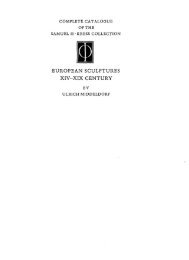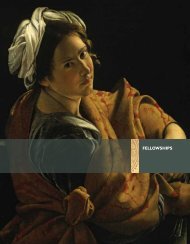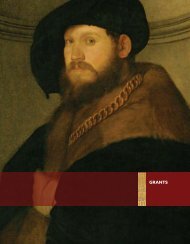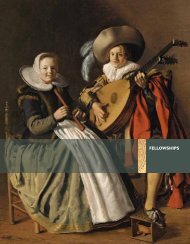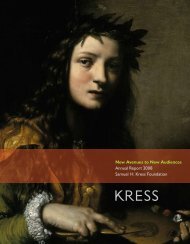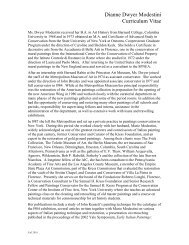The Campus Art Museum - Samuel H. Kress Foundation
The Campus Art Museum - Samuel H. Kress Foundation
The Campus Art Museum - Samuel H. Kress Foundation
You also want an ePaper? Increase the reach of your titles
YUMPU automatically turns print PDFs into web optimized ePapers that Google loves.
<strong>Museum</strong> Staff<br />
An art history professor described the kind of museum staff sought at Oberlin as a<br />
“very particular kind of person.” She went on to say:<br />
<strong>The</strong>y have to have a teaching mission as well as a curatorial mission. People<br />
who come here who just want to make exhibits so they can land a better job in<br />
LA and New York—and there have been people like that here—aren’t the ones<br />
who are most successful. <strong>The</strong> most successful people are those that… believe<br />
they are here to show young people the best art they can show them and find<br />
undiscovered stuff and have a visionary idea of art and collecting and of<br />
making that museum a very unique and very amazing place.<br />
“<strong>The</strong>y have to have a<br />
teaching mission as<br />
well as a curatorial<br />
mission.... <strong>The</strong> most<br />
successful people are<br />
those that believe<br />
they are here to show<br />
young people the<br />
best art... and have<br />
a visionary idea of<br />
art and... making<br />
that museum a very<br />
unique... place.”<br />
<strong>The</strong> curators and educators 5 with whom I talked are working to make<br />
museums “unique and amazing places.” <strong>The</strong>y enjoy the work that they are doing<br />
and are good at making connections with faculty and students throughout the<br />
campus community and with teachers, docents, volunteers, grade school students,<br />
and others in the larger community. <strong>The</strong>y have research interests and seek to share<br />
their work in a variety of ways, including publications and presentations. <strong>The</strong>y love<br />
being with art and enjoy teaching. Knowing that no job is perfect, I probed for their<br />
frustrations and identified four main areas: job expectations; institutional status;<br />
teaching remuneration; and ability to pursue scholarship.<br />
Job Expectations. This category could be summed up as “too much to do<br />
without enough time or money,” and, in a sense, all of the frustrations are a subset<br />
of this grouping. Curators and educators have a mixture of job expectations. In<br />
varying degrees, they develop and curate exhibitions, work with interns and other<br />
students, teach or co-teach courses, do research, publish, present at conferences and<br />
workshops, teach docents, develop museum “tours” for grade school to university/<br />
college classes and community groups, sit on student thesis or dissertation<br />
committees, participate in college/university committees, organize and coordinate<br />
public talks or other museum events, work with donors, and more. No wonder, in<br />
places where resources are stretched and museum staff is limited, a curator might<br />
say, “We try to do everything we can. We have a very small staff. We’re a bit worn<br />
out right now.” <strong>The</strong> curators and educators in the study are a creative, talented<br />
group of people, however, and even when stretched, are likely to put a positive spin<br />
on things, as did this curator, “<strong>The</strong> wonderful thing about being in a small museum<br />
with a really deep collection is that I am the only curator which is hard, but on the<br />
other hand, I get to curate whatever I want.”<br />
Institutional Status. How museum curators, educators, and other staff<br />
are classified as professionals varies from one institution to another. Categories<br />
include academic research staff, research associate, researcher/scholar, professional<br />
5. Curators in the study tend to have primary responsibility for working with museum collections to create exhibitions<br />
and facilitate dialogue among art, artists, and audiences. <strong>Museum</strong> staff who work with educational programs, school<br />
tours, and docent training might have the title of curator of education, education director, or museum educator. Some<br />
museums have created a position for a person to liaise with faculty and the academic curriculum. <strong>The</strong>se positions are<br />
variously called academic curator, academic coordinator, or director of academic programs. In this section, I am referring<br />
to all these positions when stating “curators and educators.”<br />
It’s Not History and Culture Alone: People Make the <strong>Museum</strong><br />
18



